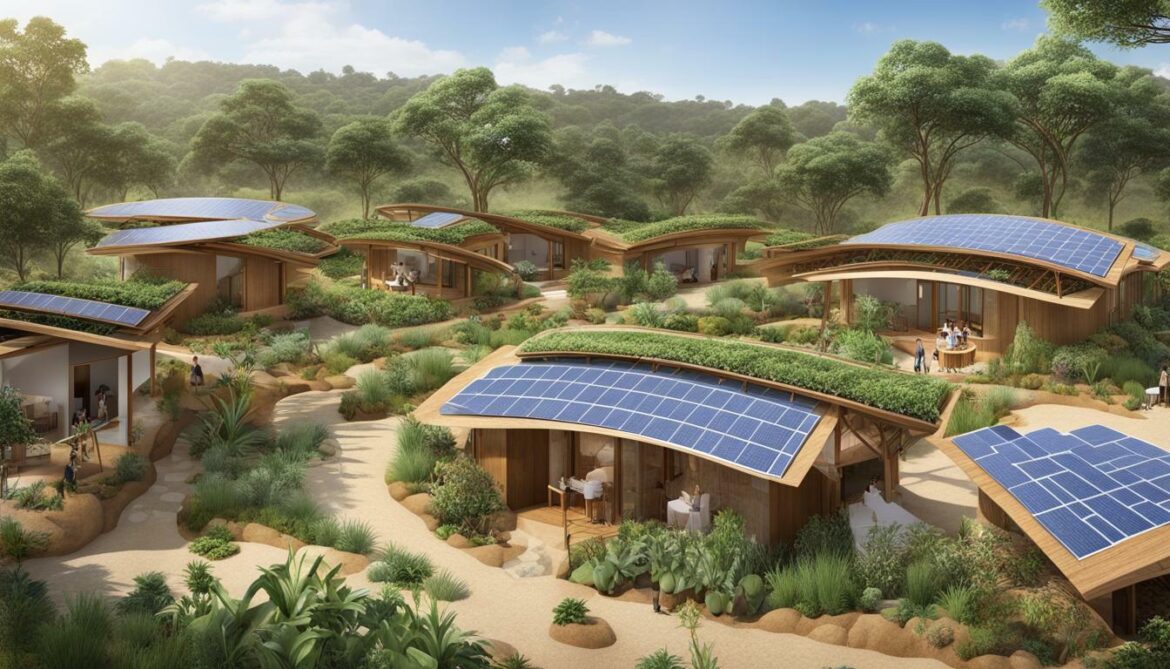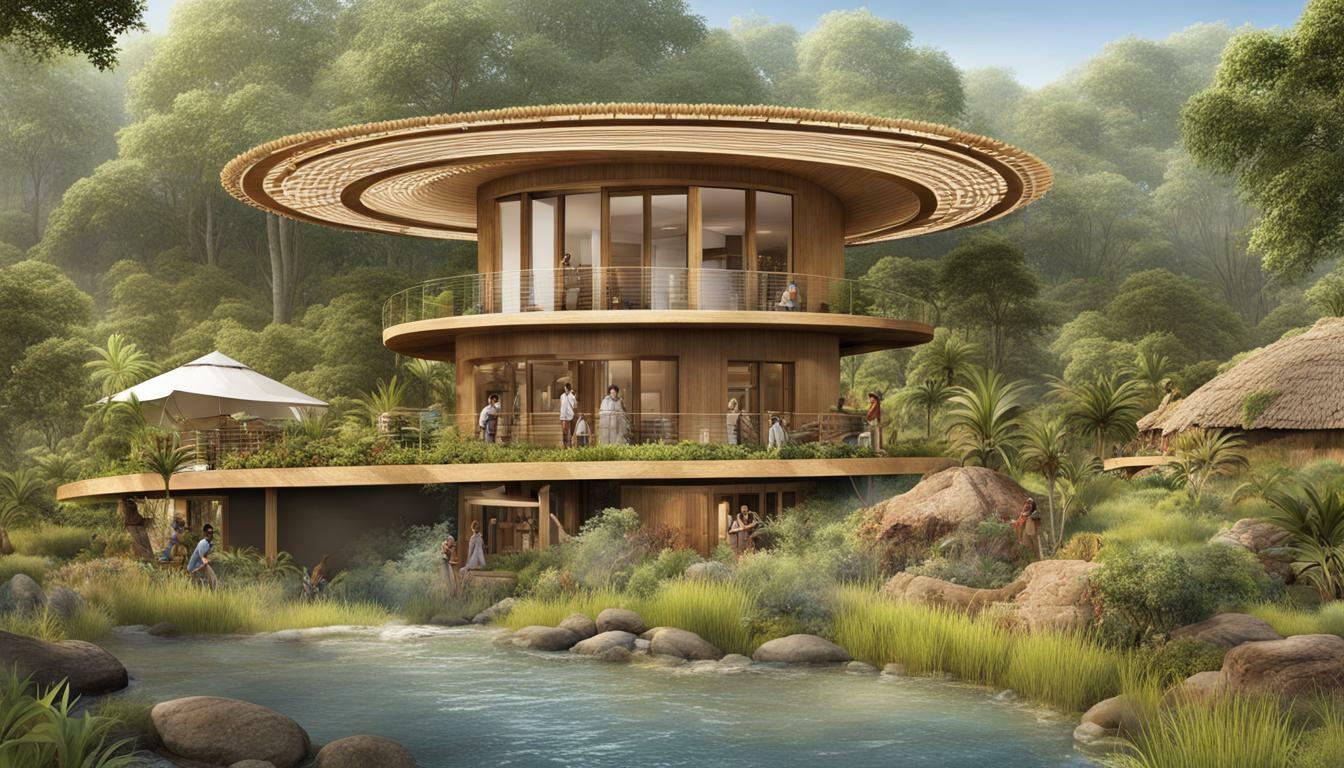Community-Centered Architecture is more than just constructing buildings. It’s about designing spaces that promote inclusivity, sustainability, and the overall well-being of communities. Architecture for communities should take into account the unique needs and values of the people who will use the spaces. Indigenous populations, in particular, have been historically marginalized and excluded from the design process, resulting in spaces that do not meet their needs or reflect their culture.
Sustainable community design incorporates environmentally-friendly practices and materials, social inclusivity, and economic considerations. It’s not just about creating a one-off building but about developing a sustainable ecosystem that can thrive for generations. Inclusive architecture creates spaces that are accessible to all, regardless of ability, age, or cultural background, encouraging a sense of belonging and ownership.
Key Takeaways:
- Community-Centered Architecture prioritizes inclusivity, sustainability, and community well-being.
- Indigenous populations have traditionally been excluded from the design process, leading to spaces that do not meet their needs.
- Sustainable community design takes into account social, environmental, and economic factors, promoting long-term resilience and well-being.
- Inclusive architecture creates spaces that are accessible to all, fostering a sense of belonging and ownership.
The Importance of Community-Driven Design
In order to truly empower and support indigenous populations through architecture, it is important to adopt a community-driven design approach. This means engaging with the local community through participatory design processes and prioritizing their needs and wants throughout the design and development process.
The principles of community-driven design are based on the belief that the people who live and work in a space know it best. Therefore, community engagement in architecture can lead to the creation of spaces that are not only functional but also meaningful and reflective of the local culture and identity.
Participatory design is a key aspect of community-driven design. This involves actively involving community members in the design process, from initial planning stages to final implementation. By valuing the input and ideas of the local population, architects and designers can create spaces that are truly owned and appreciated by the community.

“Participatory design involves actively involving community members in the design process, from initial planning stages to final implementation.”
Community engagement in architecture is also crucial in establishing a sense of pride and ownership within the community. When people feel that they have had an active role in the creation of a space, they are more likely to care for and protect it over time, resulting in a longer lifespan for the building or structure.
In summary, community-driven design and active engagement with the local population are crucial components of community-centered architecture. By prioritizing the needs and wants of the community throughout the design process, architects and designers can create spaces that are not only functional but also deeply meaningful and reflective of the local culture and identity.
Designing for Social Impact
Architecture has the potential to not only create visually stunning buildings, but also to positively impact communities. Social architecture is an approach where architects not only design for aesthetic purposes but also focus on designing spaces that address social challenges and promote well-being. The impact of architecture can be seen across different aspects of community development.
Health and Well-being
Innovative design can lead to improved health and well-being in communities. By creating spaces that are conducive to physical activity and mental well-being, architects can contribute to the overall health of a community. A prime example of this is the redesign of city centres or parks to encourage walking or cycling, providing access to green spaces, and incorporating features that encourage social interaction.

Economic Development
Architecture can play a significant role in the economic development of a community. By designing buildings that meet the needs of local businesses and industries, architects can help create an environment for economic growth. Building reuse and historic preservation projects can also spur economic development while preserving the unique history and character of a community.
Cultural Preservation
Architecture can also play a role in preserving a community’s culture and heritage. By incorporating traditional design elements and materials, architects can create buildings that reflect a community’s values and traditions. This approach ensures that the community’s culture is preserved and passed down to future generations.
Designing for social impact requires a deep understanding of a community’s needs, values, and aspirations. By working collaboratively with community members, architects can create inclusive spaces that benefit everyone. Architecture and community development go hand in hand, and social architecture can create positive impacts that last for generations.
Sustainable Community Design
Community-Centered Architecture must consider the long-term sustainability of the community it serves. Sustainable community design practices aim to enhance the environmental, social, and economic aspects of a community, thus ensuring that it remains resilient and well-functioning in the long run.
One critical aspect of sustainable design is reducing the environmental impact of buildings and infrastructure. This can be achieved through measures such as energy-efficient building materials, renewable energy sources, and efficient water management systems.
However, sustainability goes beyond environmental considerations. It also involves addressing social and economic aspects of the community. For example, sustainable design can encourage local economic development by incorporating locally-sourced materials and providing job opportunities. Additionally, it can promote social well-being by incorporating green spaces, walkways, and other community-oriented facilities, thus improving residents’ quality of life.

Incorporating sustainable design practices into Community-Centered Architecture is crucial in ensuring that communities thrive in the long term. By considering the environmental, social, and economic aspects of the community, we can create spaces that are resilient, self-sufficient, and adaptive to changes. This is essential, especially for indigenous populations who often have a profound connection to their land and require sustainable design solutions that are respectful of their cultural practices and traditions.
Conclusion
In conclusion, Community-Centered Architecture is a powerful tool for empowering indigenous populations through design. By prioritising community-driven and participatory design processes, architects can create spaces that truly meet the needs of the people they serve.
Social impact is a key aspect of this approach, with thoughtful design practices addressing social challenges and promoting community well-being. Sustainable community design further enhances the environmental, social, and economic aspects of a community, fostering long-term resilience and prosperity.
Emphasising Inclusive and Sustainable Design
Inclusive and sustainable design are essential components of Community-Centered Architecture, ensuring that communities are not only empowered, but also thriving and resilient. The value of this approach cannot be overstated, especially in the context of indigenous populations who have suffered from marginalisation and displacement for centuries.
As architects, we must embrace the principles of community-driven and participatory design, prioritising local knowledge, culture, and values in our work. By doing so, we can create spaces that are not only functional and beautiful, but also transformative in their impact on people’s lives.
In short, Community-Centered Architecture has the potential to change the world, one community at a time. Let’s embrace this approach, and work towards a more inclusive, sustainable, and equitable future for all.
FAQ
Q: What is Community-Centered Architecture?
A: Community-Centered Architecture is a design approach that focuses on empowering indigenous populations through tailored design solutions. It aims to create inclusive and sustainable communities that meet the specific needs of the local population.
Q: Why is community-driven design important in architecture?
A: Community-driven design is important in architecture because it fosters a sense of ownership and pride among the local population. Through participatory design processes and active community engagement, spaces are created that truly meet the needs of the community.
Q: How does architecture contribute to social impact and community development?
A: Architecture has the potential to address social challenges, promote well-being, and contribute to the overall development of a community. Thoughtful design can create spaces that enhance community cohesion and improve the quality of life for residents.
Q: What is sustainable community design?
A: Sustainable community design focuses on enhancing the environmental, social, and economic aspects of a community. It aims to create resilient communities that are environmentally friendly, socially inclusive, and economically viable in the long term.
Q: What is the importance of inclusive and sustainable design in creating thriving communities?
A: Inclusive and sustainable design is crucial in creating thriving communities because it ensures that all residents, including indigenous populations, have access to well-designed and environmentally friendly spaces. This promotes community well-being, resilience, and long-term prosperity.





















Post comments (0)